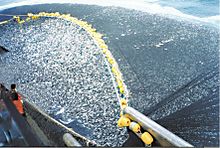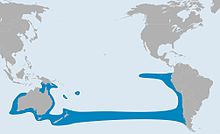Chilean jack mackerel
| Chilean jack mackerel | |
|---|---|
 |
|
| A school of about 400 tons of Chilean jack mackerel encircled by a purse seine | |
| Scientific classification | |
| Kingdom: | Animalia |
| Phylum: | Chordata |
| Class: | Actinopterygii |
| Order: | Perciformes |
| Family: | Carangidae |
| Genus: | Trachurus |
| Species: | T. murphyi |
| Binomial name | |
|
Trachurus murphyi Nichols, 1920 |
|
 |
|
|
Estimated distribution
|
|
The Chilean jack mackerel (Trachurus murphyi) sometimes called the Inca scad, is a species of jack mackerel in the genus Trachurus of the family Carangidae. Since the 1970s, it has become one of the world's more important commercial fish species. High volumes have been harvested, but the fishery may now be in danger of collapsing.
Chilean jack mackerels are commonly 45 cm (18 in) long, though they can grow to 70 cm (28 in). They have elongated and laterally compressed bodies. The head is large with well-developed transparent protective membranes (the adipose eyelid) covering the eyes. The mouth is also large, with the rear edge of the lower jaw aligning with the front edge of the eyes. It possesses small teeth. Each opercle of the gill covers has a distinct notch on its rear edge. The second dorsal fin is much longer than the first. The pectoral fins are long and pointed. The origin of the pelvic fins is below the bottom point of attachment of the pectorals. The anal fin is also long, but shorter than the second dorsal fin. At its front are two strong spines. The upper parts of the body are metallic blue in color, while the bottom surfaces are a silvery white.
The Chilean jack mackerel is an epipelagic fish that swims in schools around coasts and in the open ocean. Normally it swims at depths between 10 and 70 m, but it can swim as deep as 300 m. They are found in the south Pacific off the coasts of Chile and Peru, around New Zealand and south Australia, and in a band across the open ocean in between. In 1993, Elizarov et al. referred to this band on the high seas as the 'jack mackerel belt'. The jack mackerel belt ranges from 35 to 45°S, which means it has a north-south breadth of 10° (about 1100 km). "Spawning groups concentrate mainly in the north of 40°S in spring and summer and south of 40°S in autumn and winter to feed". Chilean jack mackerel normally spawn in summer. Their eggs are pelagic, that is, they float free in the open sea.
...
Wikipedia

